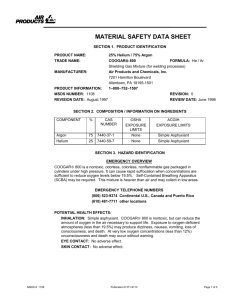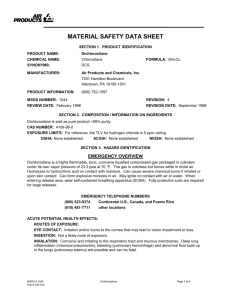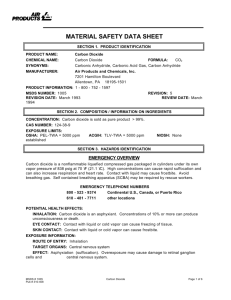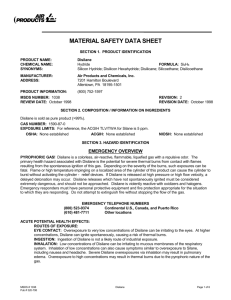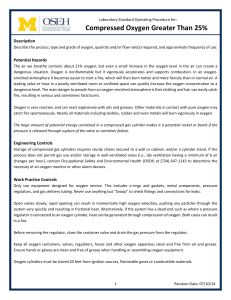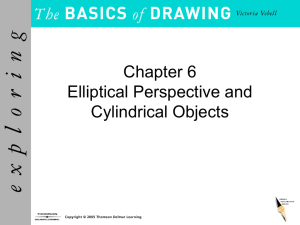Oxygen, Compressed
advertisement
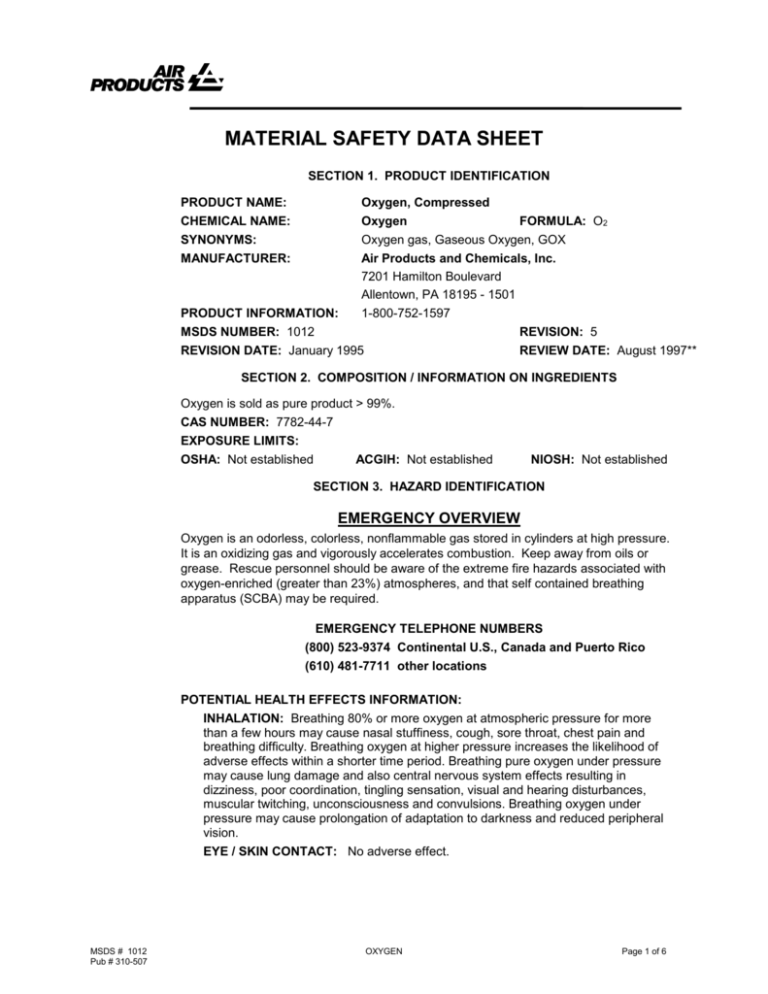
MATERIAL SAFETY DATA SHEET SECTION 1. PRODUCT IDENTIFICATION PRODUCT NAME: CHEMICAL NAME: SYNONYMS: MANUFACTURER: Oxygen, Compressed Oxygen FORMULA: O2 Oxygen gas, Gaseous Oxygen, GOX Air Products and Chemicals, Inc. 7201 Hamilton Boulevard Allentown, PA 18195 - 1501 PRODUCT INFORMATION: 1-800-752-1597 MSDS NUMBER: 1012 REVISION: 5 REVISION DATE: January 1995 REVIEW DATE: August 1997** SECTION 2. COMPOSITION / INFORMATION ON INGREDIENTS Oxygen is sold as pure product > 99%. CAS NUMBER: 7782-44-7 EXPOSURE LIMITS: OSHA: Not established ACGIH: Not established NIOSH: Not established SECTION 3. HAZARD IDENTIFICATION EMERGENCY OVERVIEW Oxygen is an odorless, colorless, nonflammable gas stored in cylinders at high pressure. It is an oxidizing gas and vigorously accelerates combustion. Keep away from oils or grease. Rescue personnel should be aware of the extreme fire hazards associated with oxygen-enriched (greater than 23%) atmospheres, and that self contained breathing apparatus (SCBA) may be required. EMERGENCY TELEPHONE NUMBERS (800) 523-9374 Continental U.S., Canada and Puerto Rico (610) 481-7711 other locations POTENTIAL HEALTH EFFECTS INFORMATION: INHALATION: Breathing 80% or more oxygen at atmospheric pressure for more than a few hours may cause nasal stuffiness, cough, sore throat, chest pain and breathing difficulty. Breathing oxygen at higher pressure increases the likelihood of adverse effects within a shorter time period. Breathing pure oxygen under pressure may cause lung damage and also central nervous system effects resulting in dizziness, poor coordination, tingling sensation, visual and hearing disturbances, muscular twitching, unconsciousness and convulsions. Breathing oxygen under pressure may cause prolongation of adaptation to darkness and reduced peripheral vision. EYE / SKIN CONTACT: No adverse effect. MSDS # 1012 Pub # 310-507 OXYGEN Page 1 of 6 EXPOSURE INFORMATION: ROUTE OF ENTRY: Inhalation TARGET ORGANS: Eyes, central nervous system MEDICAL CONDITIONS AGGRAVATED BY OVEREXPOSURE: Patients with chronic obstructive pulmonary disease retain carbon dioxide abnormally. If oxygen is administered to them, raising the oxygen concentration in the blood depresses their breathing and raises their retained carbon dioxide to a dangerous level. CARCINOGENIC POTENTIAL: Oxygen is not listed as a carcinogen or potential carcinogen by NTP, IARC, or OSHA Subpart Z. SECTION 4. FIRST AID INHALATION: Move victim to fresh air or if in elevated pressures reduce oxygen pressures to one tmosphere. Call a physician. The physician should be advised that the victim has been exposed to a high concentration of oxygen. No treatment is required in the absence of symptoms or high pressure exposure. EYE / SKIN CONTACT: Not applicable NOTES TO PHYSICIAN: Animal studies suggest that the administration of certain drugs, including phenothiazine drugs and chloroquine, increase the susceptibility to toxicity from oxygen at high pressures. Animal studies also indicate that vitamin "E" deficiency may increase susceptibility to oxygen toxicity. Airway obstruction during high oxygen tension may cause alveolar collapse following absorption of the oxygen. Similarly, occlusion of the Eustachian tubes may cause retraction of the eardrum and obstruction of the paranasal sinuses may produce "vacuum-type" headache. All individuals exposed for long periods to oxygen at high pressure and who exhibit overt oxygen toxicity should have ophthalmologic examinations. SECTION 5. FIRE AND EXPLOSION FLASH POINT: Not applicable AUTOIGNITION: Nonflammable FLAMMABLE LIMITS: Nonflammable EXTINGUISHING MEDIA: Oxygen is nonflammable but will support combustion. Use extinguishing media appropriate for surrounding fire. HAZARDOUS COMBUSTION PRODUCTS: None SPECIAL FIRE FIGHTING INSTRUCTIONS: Evacuate all personnel from the danger area. If possible, shut off flow of oxygen which is supporting the fire. Immediately cool containers with water spray from maximum distance. When cool move cylinders from fire area, if possible without risk. Self contained breathing apparatus may be required for rescue workers. UNUSUAL FIRE AND EXPLOSION HAZARDS: Oxygen vigorously accelerates combustion. Some materials which are noncombustible in air will burn in the presence of an oxygen enriched atmosphere (greater than 23%). Fire resistant clothing may burn and offer no protection in oxygen rich atmospheres. Oxygen may form explosive compounds when exposed to combustible materials or oil, grease, and other hydrocarbon materials. Pressure in a container can build up due to heat and it may rupture if pressure relief devices should fail to function. Upon exposure to intense heat or flame cylinder will vent rapidly and/or rupture violently. Most cylinders are designed to vent contents when exposed to elevated temperatures. Pressure in a container can build up due to heat and it may rupture if pressure relief devices should fail to function. MSDS # 1012 Pub # 310-507 OXYGEN Page 2 of 6 SECTION 6. ACCIDENTAL RELEASE MEASURES Evacuate all personnel from affected area. Shut off source of oxygen if possible. Increase ventilation to release area. Personnel who have been exposed to high concentrations of oxygen should stay in a wellventilated or open area for 30 minutes before going into a confined space or near an ignition source. If leak is from container or its valve, call the Air Products emergency telephone number. If leak is in user system close cylinder valve and vent pressure before attempting repairs. SECTION 7. STORAGE AND HANDLING STORAGE: Cylinders should be stored upright in a well-ventilated, secure area, protected from the weather. Storage area temperatures should not exceed 125 蚌 (52 蚓) and area should be free of combustible materials. Storage should be away from heavily traveled areas and emergency exits. Avoid areas where salt or other corrosive materials are present. Cylinders should be separated from flammables by a minimum distance of 20 ft. or by a barricade of non-combustible material at least five ft. high having a fire resistance rating of at least 1/2 hour. Valve protection caps and valve outlet seals should remain on cylinders not connected for use. Separate full from empty cylinders. Avoid excessive inventory and storage time. Use a first-in first-out system. Keep good inventory records. HANDLING: Do not drag, roll, or slide cylinder. Use a suitable handtruck designed for cylinder movement. Never attempt to lift a cylinder by its cap. Secure cylinders at all times while in use. Use a pressure reducing regulator or separate control valve to safely discharge gas from cylinder. Use a check valve to prevent reverse flow into cylinder. Do not overheat cylinder to increase pressure or discharge rate. Always open cylinder valve slowly. Do not use rapid opening valves (i.e., ball valves). If user experiences any difficulty operating cylinder valve, discontinue use and contact supplier. Never insert an object (e.g., wrench, screwdriver, pry bar, etc.) into valve cap openings. Doing so may damage valve causing a leak to occur. Use an adjustable strap-wrench to remove over-tight or rusted caps. All gauges, valves, regulators, piping and equipment to be used in oxygen service must be cleaned for oxygen service in accordance with Compressed Gas Association pamphlet G-4.1. Carbon steel, stainless steel, copper, brass, nickel and their alloys are materials of construction that can be used in oxygen service. Use piping and equipment adequately designed to withstand pressures to be encountered. Oxygen is not to be used as a substitute for compressed air. Never use an oxygen jet for cleaning purposes of any sort, especially clothing, as it increases the likelihood of an engulfing fire. Use a check valve or other protective apparatus in any line or piping from the cylinder to prevent reverse flow. When used in welding and cutting read and understand the manufacturer's instructions and the precautionary label on the products. Never strike an arc on a compressed gas cylinder or make a cylinder a part of an electrical circuit. SPECIAL REQUIREMENTS: Always store and handle compressed gases in accordance with Compressed Gas Association, Inc. (ph. 703-412-0900) pamphlet CGA P-1, Safe Handling of Compressed Gases in Containers. Local regulations may require specific equipment for storage or use. CAUTION: Compressed gas cylinders shall not be refilled except by qualified producers of compressed gases. Shipment of a compressed gas cylinder which has not been filled by the owner or with the owner written consent is a violation of federal law. SECTION 8. PERSONAL PROTECTION / EXPOSURE CONTROL ENGINEERING CONTROLS: Provide ventilation and/or local exhaust to prevent accumulation of high concentrations of gas (greater than 23%). RESPIRATORY PROTECTION: GENERAL USE: None required EMERGENCY: Use SCBA do to possibility of fire when concentrations exceed 23%. OTHER PROTECTIVE EQUIPMENT: Safety shoes and work gloves are recommended when handling cylinders. Clothing exposed to high concentrations may retain oxygen 30 minutes or longer and become a potential fire hazard. Stay away from ignition sources. MSDS # 1012 Pub # 310-507 OXYGEN Page 3 of 6 SECTION 9. PHYSICAL AND CHEMICAL PROPERTIES APPEARANCE: Colorless gas ODOR: Odorless MOLECULAR WEIGHT: 32.0 BOILING POINT (1 atm): -297.3 蚌 (-183.0 蚓) SPECIFIC GRAVITY (Air =1): 1.10 SPECIFIC VOLUME (at 70 F 21.1 C) and 1 atm): 12.08 ft3/lb (0.754 m3/kg) FREEZING / MELTING POINT: -361.9 蚌 (-218.8 蚓) VAPOR PRESSURE: Not applicable at 70蚌 GAS DENSITY (At 70蚌 (21.1蚓) and 1 Atm): 0.083 lb /ft3 (1.326 kg/m3) SOLUBILITY IN WATER (Vol./Vol. at 32蚌 (0蚓)): 0.049 SECTION 10. REACTIVITY / STABILITY CHEMICAL STABILITY: Stable CONDITIONS TO AVOID: None INCOMPATIBILITY: Oils, grease, hydrocarbons and flammable materials. HAZARDOUS DECOMPOSITION PRODUCTS: None HAZARDOUS POLYMERIZATION: Will not occur SECTION 11. TOXICOLOGICAL INFORMATION At atmospheric concentration and pressure, oxygen poses no toxicity hazards. Premature infants exposed to high oxygen concentrations may suffer delayed retinal damage which can progress to retinal detachment and blindness. Retinal damage may also occur in adults exposed to 100% oxygen for extended periods (24 to 48 hr). At two or more atmospheres central nervous system (CNS) toxicity occurs. Symptoms include nausea, vomiting, dizziness or vertigo, muscle twitching, vision changes, and loss of consciousness and generalized seizures. At three atmospheres, CNS toxicity occurs in less than two hours, and at six atmospheres in only a few minutes. SECTION 12. ECOLOGICAL INFORMATION The atmosphere contains 21% oxygen. No adverse ecological effects are expected. Oxygen does not contain any Class I or Class II ozone depleting chemicals. Oxygen is not listed as a marine pollutant by DOT (49 CFR 171). SECTION 13. DISPOSAL UNUSED PRODUCT / EMPTY CONTAINER: Return container and unused product to supplier. Do not attempt to dispose of residual or unused quantities. DISPOSAL: For emergency disposal, secure cylinder and slowly discharge gas to the atmosphere in a well ventilated area or outdoors. SECTION 14. TRANSPORTATION DOT HAZARD CLASS: 2.2 (Nonflammable Gas) DOT SHIPPING NAME: Oxygen, compressed REPORTABLE QUANTITY (RQ): None MSDS # 1012 Pub # 310-507 OXYGEN DOT SHIPPING LABEL: Nonflammable Gas, Oxidizer IDENTIFICATION NUMBER: UN 1072 PLACARD: Nonflammable Gas or Oxygen 4 of 6 SPECIAL SHIPPING INFORMATION: Cylinders should be transported in a secure upright position in a well ventilated truck. Never transport in passenger compartment of a vehicle. An oxygen label may be used for domestic shipment in the United States and Canada in place of the Non-flammable and Oxidizer labels (49CFR Part 172). SECTION 15. REGULATORY INFORMATION U.S. FEDERAL REGULATIONS: EPA - ENVIRONMENTAL PROTECTION AGENCY: CERCLA: Comprehensive Environmental Response, Compensation, and Liability Act of 1980 requires notification to the National Response Center of releases of quantities of hazardous substances equal to or greater than the reportable quantities (RQ) in 40 CFR 302.4. CERCLA Reportable Quantity: None SARA TITLE III: Superfund Amendments and Reauthorization Act of 1986 SECTION 302: Requires emergency planning based on threshold planning quantities (TPQ) and release reporting based on reportable quantities (RQ) of EPA extremely hazardous substances (40 CFR 355). Oxygen is not listed as an Extremely Hazardous Substance. SECTIONS 311/312: Require submission of material safety data sheets (MSDSs) and chemical inventory reporting with identification of EPA defined hazard classes. The hazard classes for this product are: IMMEDIATE: No PRESSURE: Yes DELAYED: No REACTIVITY: No FIRE: Yes SECTION 313: Requires submission of annual reports of releases of toxic chemicals that appear in 40 CFR 372. Oxygen is not listed as a toxic chemical. 40 CFR PART 68: Risk Management for Chemical Accident Release Prevention. Requires the development and implementation of risk management programs at facilities that manufacture, use, store, or otherwise handle regulated substances in quantities that exceed specified thresholds. Oxygen is not listed as a regulated substance. TOXIC SUBSTANCE CONTROL ACT (TSCA): Oxygen is listed on the TSCA inventory. OSHA - OCCUPATIONAL SAFETY AND HEALTH ADMINISTRATION 29 CFR 1910.119: Process Safety Management of Highly Hazardous Chemicals. Requires facilities to develop a process safety management program based on Threshold Quantities (TQ) of highly hazardous chemicals. Oxygen is not listed as a Highly Hazardous Chemical. STATE REGULATIONS CALIFORNIA: Proposition 65: This product does NOT contain any listed substances for which the State of California requires warning under this statute. SCAQMD Rule: VOC = Not applicable MSDS # 1012 Pub # 310-507 OXYGEN 5 of 6 SECTION 16. SUPPLEMENTAL INFORMATION HAZARD RATINGS: NFPA RATINGS: HEALTH: FLAMMABILITY: REACTIVITY: SPECIAL: 0 0 0 OX (oxidizer) HMIS RATINGS: HEALTH: FLAMMABILITY: REACTIVITY: 0 0 0 **Documents with Revision Date January 1995 and Review Date August 1997 are identical in content and either may be used. MSDS # 1012 Pub # 310-507 OXYGEN 6 of 6
